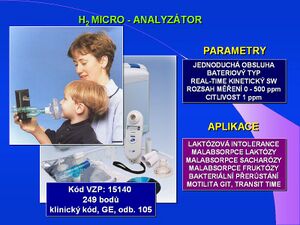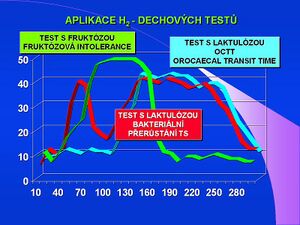Dechové testy s vodíkem
Moderní, neinvazivní funkční diagnostika v gastroenterologii zahrnuje celou řadu dechových testů založených na měření koncentrace vodíku ve vydechovaném vzduchu. Koncentrace vodíku H2 ve vydechovaném vzduchu stoupá přímo úměrně k hydrolýze podaného substrátu. Po podání testovaného substrátu jsou odebírány vzorky vydechovaného vzduchu a koncentrace H2 je stanovována metodou plynové chromatografie nebo pomocí velmi jednoduchých ručních, bateriových analyzátorů (H2-monitorů) s elektrochemickým senzorem, které se rutinně používají v pediatrii v dieferenciální diagnostice malabsorpčního syndromu. Vhodným substrátem může být laktóza (k diagnostice laktózové intolerance), sacharóza, sorbitol, fruktóza, glukóza nebo i D-xylóza, která byla dříve běžně používána pro D-xylózový absorpční test.
Aplikace H2 dechových testů pokrývají širokou oblast. Kromě zmíněné diferenciální diagnostiky malabsorpčního syndromu je to syndrom bakteriálního přerůstání v tenkém střevě (SBBO, substrátem je např. D-xylóza), stanovení motility gastrointestinálního traktu, orocékální transit time (OCCT, substrátem je např. inulin) – small bowel transit time (SBTT) označovaný také zkratkou LHBT (podaným substrátem je laktulóza), nebo kvalita přípravy tlustého střeva před endoskopickým vyšetřením. Doba pasáže gastrointestinálním traktem je důležitým údajem pro vyhodnocení a interpretaci jiných funkčních testů, a je proto často kombinován s dalšími dechovými testy, např. 13C/H2-laktózový test, kdy je hodnoceno enzymatické štěpení laktózy (markerem je uhlík 13C) a současně jako korekce motility, pasáže je použito bakteriálního štěpení v tlustém střevu (markerem je H2).
Odkazy[upravit | editovat zdroj]
Související články[upravit | editovat zdroj]
Zdroj[upravit | editovat zdroj]
- se svolením autora převzato z KOCNA, Petr. GastroLab : MiniEncyklopedie laboratorních metod v gastroenterologii [online]. ©2002. Poslední revize 2011-01-08, [cit. 2011-03-04]. <http://www1.lf1.cuni.cz/~kocna/glab/glency1.htm>.
Použitá literatura[upravit | editovat zdroj]
- RAO, SS, et al. Ability of the normal human small intestine to absorb fructose: evaluation by breath testing. Clin Gastroenterol Hepatol. 2007, vol. 5, no. 8, s. 959-63, ISSN 1542-3565 (Print), 1542-7714 (Electronic). PMID: 17625977.
- SCHNEIDER, AR, et al. The inulin hydrogen breath test accurately reflects orocaecal transit time. Eur J Clin Invest. 2007, vol. 37, no. 10, s. 802-7, ISSN 0014-2972 (Print), 1365-2362 (Electronic). PMID: 17727672.
- DICAMILLO, M, et al. Hydrogen breath test for diagnosis of lactose malabsorption: the importance of timing and the number of breath samples. Can J Gastroenterol. 2006, vol. 20, no. 4, s. 265-8, ISSN 0835-7900 (Print). PMID: 16609755.
- NUCERA, G, et al. Abnormal breath tests to lactose, fructose and sorbitol in irritable bowel syndrome may be explained by small intestinal bacterial overgrowth. Aliment Pharmacol Ther. 2005, vol. 21, no. 11, s. 1391-5, ISSN 0269-2813 (Print), 1365-2036 (Electronic). PMID: 15932370.
- OWIRA, PM, et al. Comparison of inulin and lactulose as reference standards in the breath hydrogen test assessment of carbohydrate malabsorption in patients with chronic pancreatic exocrine insufficiency. Dig Dis Sci. 2005, vol. 50, no. 6, s. 1058-63, ISSN 0163-2116 (Print), 1573-2568 (Electronic). PMID: 15986854.
- WALTERS, B, et al. Detection of bacterial overgrowth in IBS using the lactulose H2 breath test: comparison with 14C-D-xylose and healthy controls. Am J Gastroenterol. 2005, vol. 100, no. 7, s. 1566-70, ISSN 0002-9270 (Print), 1572-0241 (Electronic). PMID: 15984983.
- SYMONDS, EL, et al. A combined 13CO2/H2 breath test can be used to assess starch digestion and fermentation in humans. J Nutr. 2004, vol. 134, no. 5, s. 1193-6, ISSN 0022-3166 (Print), 1541-6100 (Electronic). PMID: 15113969.
- URITA, Y, et al. Hydrogen breath test as an indicator of the quality of colonic preparation for colonoscopy. Gastrointest Endosc. 2003, vol. 57, no. 2, s. 174-7, ISSN 0016-5107 (Print), 1097-6779 (Elestronic). PMID: 12556779.
- PARLESAK, A, et al. Prevalence of small bowel bacterial overgrowth and its association with nutrition intake in nonhospitalized older adults. J Am Geriatr Soc. 2003, vol. 51, no. 6, s. 768-73, ISSN 0002-8614 (Print), 1532-5415 (Electronic). PMID: 12757562.
- GEBOES, KP, et al. Inulin is an ideal substrate for a hydrogen breath test to measure the orocaecal transit time. Aliment Pharmacol Ther. 2003, vol. 18, no. 7, s. 721-9, ISSN 0269-2813 (Print), 1365-2036 (Electronic). PMID: 14510746.
- CASELLAS, F, et al. Applicability of short hydrogen breath test for screening of lactose malabsorption. Dig Dis Sci. 2003, vol. 48, no. 7, s. 1333-8, ISSN 0163-2116 (Print), 1573-2568 (Electronic). PMID: 12870791.
- CHOI, YK, et al. Fructose intolerance: an under-recognized problem. Am J Gastroenterol. 2003, vol. 98, no. 6, s. 1348-53, ISSN 0002-9270 (Print), 1572-0241 (Electronic). PMID: 12818280.
- MURPHY, MS, et al. Use of the lactose H2 breath test to monitor mucosal healing in coeliac disease. Acta Paediatr. 2002, vol. 91, no. 2, s. 141-4, ISSN 0001-656X. PMID: 11951999.
- TURSI, A, et al. Sorbitol H2-breath test versus anti-endomysium antibodies to assess histological recovery after gluten-free diet in coeliac disease. Dig Liver Dis. 2002, vol. 34, no. 12, s. 846-50, ISSN 1590-8658 (Print), 1878-3562 (Electronic). PMID: 12643292.
- CASELLAS, F, et al. Hydrogen breath test with D-xylose for celiac disease screening is as useful in the elderly as in other age groups. Dig Dis Sci. 2001, vol. 46, no. 10, s. 2201-5, ISSN 0163-2116 (Print), 1573-2568 (Electronic). PMID: 11680597.
- LEE, WS, et al. Analysis of the breath hydrogen test for carbohydrate malabsorption: validation of a pocket-sized breath test analyser. J Paediatr Child Health. 2000, vol. 36, no. 4, s. 340-2, ISSN 1034-4810 (Print), 1440-1754 (Electronic). PMID: 10940167.



